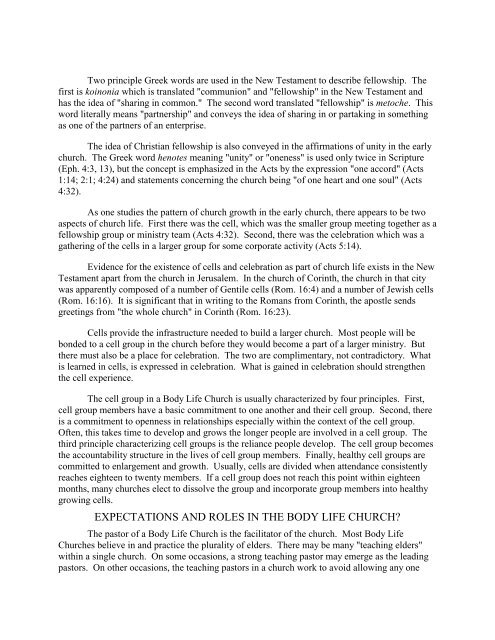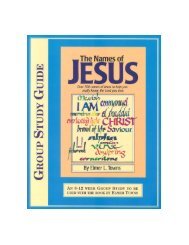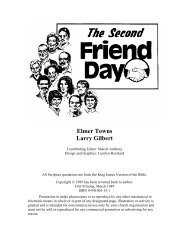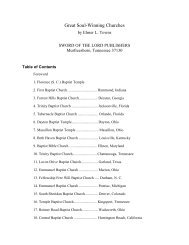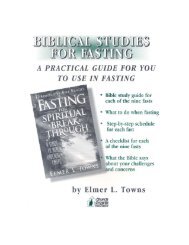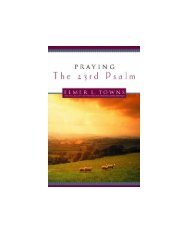PUTTING AN END TO WORSHIP WARS - Elmer Towns
PUTTING AN END TO WORSHIP WARS - Elmer Towns
PUTTING AN END TO WORSHIP WARS - Elmer Towns
- TAGS
- worship
- elmer
- towns
- elmertowns.com
You also want an ePaper? Increase the reach of your titles
YUMPU automatically turns print PDFs into web optimized ePapers that Google loves.
Two principle Greek words are used in the New Testament to describe fellowship. The<br />
first is koinonia which is translated "communion" and "fellowship" in the New Testament and<br />
has the idea of "sharing in common." The second word translated "fellowship" is metoche. This<br />
word literally means "partnership" and conveys the idea of sharing in or partaking in something<br />
as one of the partners of an enterprise.<br />
The idea of Christian fellowship is also conveyed in the affirmations of unity in the early<br />
church. The Greek word henotes meaning "unity" or "oneness" is used only twice in Scripture<br />
(Eph. 4:3, 13), but the concept is emphasized in the Acts by the expression "one accord" (Acts<br />
1:14; 2:1; 4:24) and statements concerning the church being "of one heart and one soul" (Acts<br />
4:32).<br />
As one studies the pattern of church growth in the early church, there appears to be two<br />
aspects of church life. First there was the cell, which was the smaller group meeting together as a<br />
fellowship group or ministry team (Acts 4:32). Second, there was the celebration which was a<br />
gathering of the cells in a larger group for some corporate activity (Acts 5:14).<br />
Evidence for the existence of cells and celebration as part of church life exists in the New<br />
Testament apart from the church in Jerusalem. In the church of Corinth, the church in that city<br />
was apparently composed of a number of Gentile cells (Rom. 16:4) and a number of Jewish cells<br />
(Rom. 16:16). It is significant that in writing to the Romans from Corinth, the apostle sends<br />
greetings from "the whole church" in Corinth (Rom. 16:23).<br />
Cells provide the infrastructure needed to build a larger church. Most people will be<br />
bonded to a cell group in the church before they would become a part of a larger ministry. But<br />
there must also be a place for celebration. The two are complimentary, not contradictory. What<br />
is learned in cells, is expressed in celebration. What is gained in celebration should strengthen<br />
the cell experience.<br />
The cell group in a Body Life Church is usually characterized by four principles. First,<br />
cell group members have a basic commitment to one another and their cell group. Second, there<br />
is a commitment to openness in relationships especially within the context of the cell group.<br />
Often, this takes time to develop and grows the longer people are involved in a cell group. The<br />
third principle characterizing cell groups is the reliance people develop. The cell group becomes<br />
the accountability structure in the lives of cell group members. Finally, healthy cell groups are<br />
committed to enlargement and growth. Usually, cells are divided when attendance consistently<br />
reaches eighteen to twenty members. If a cell group does not reach this point within eighteen<br />
months, many churches elect to dissolve the group and incorporate group members into healthy<br />
growing cells.<br />
EXPECTATIONS <strong>AN</strong>D ROLES IN THE BODY LIFE CHURCH?<br />
The pastor of a Body Life Church is the facilitator of the church. Most Body Life<br />
Churches believe in and practice the plurality of elders. There may be many "teaching elders"<br />
within a single church. On some occasions, a strong teaching pastor may emerge as the leading<br />
pastors. On other occasions, the teaching pastors in a church work to avoid allowing any one


